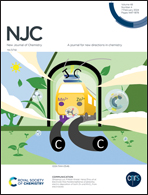A strongly coupled 3D SnS2@Ti3C2Tx heterojunction with vacancies for high-efficiency sodium storage†
Abstract
Ti3C2Tx, as some of the typical MXenes, exhibit great potential for application in rechargeable batteries due to its high conductivity, low ionic diffusion resistance, adjustable layer spacing, and surface modifiability. However, several challenges hinder its practical value, including severe self-stacking, low capacity, and unsatisfactory durability, particularly when accommodating large sodium ions. To address these issues, we have designed a SnS2@Ti3C2Tx sandwich structure with S vacancies through heterojunction engineering. Anchoring SnS2 to Ti3C2Txvia S–Ti–C bonds, this interlocking cooperative heterostructure not only mitigates Ti3C2Tx self-stacking but also exposes a significant number of active sites on the surface. Consequently, it improves the intercalation pseudocapacitance ratio, resolves the reaction kinetic hysteresis caused by the challenging removal of sodium ions, and prevents structural collapse resulting from the volume effect in SnS2. Moreover, the S vacancies effectively enhance the adsorption capacity of Na+, providing additional active sites for their adsorption. Density functional theory calculations demonstrate increased adsorption energy and reduced diffusion energy of sodium ions, thereby improving the sodium storage performance of the materials. The SnS2@Ti3C2Tx heterojunction exhibits an impressive reversible capacity of 225 mA h g−1 at 100 mA g−1, with 82% capacity retention after 1000 cycles. Furthermore, even at 500 mA g−1, a capacity of 122 mA h g−1 can still be achieved after 1000 cycles. Consequently, this research offers novel insights for future exploration in the development of anode materials for ion batteries.



 Please wait while we load your content...
Please wait while we load your content...